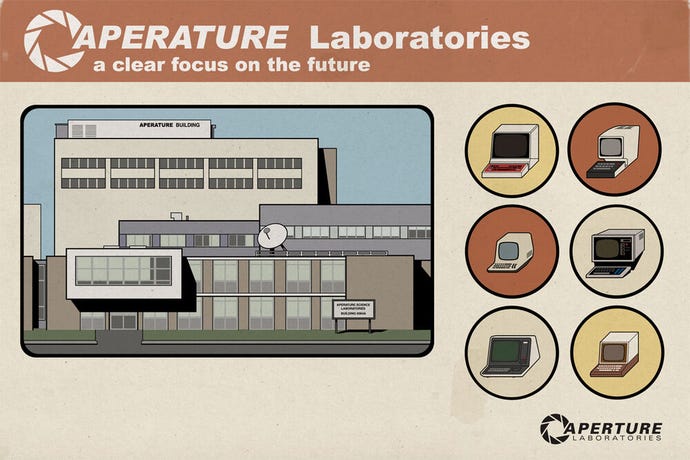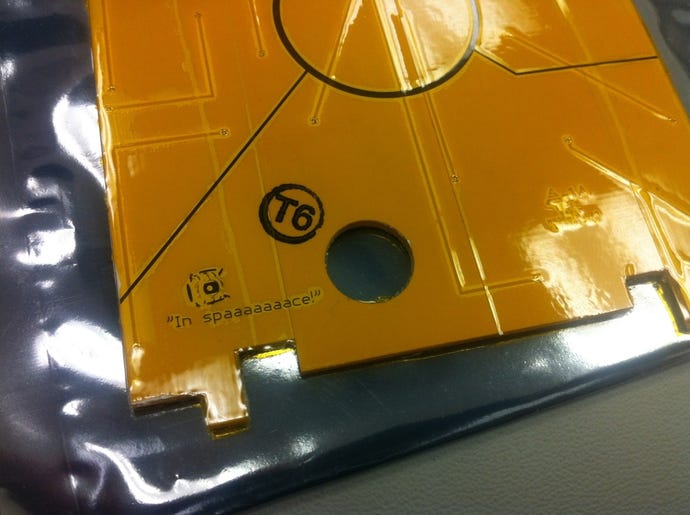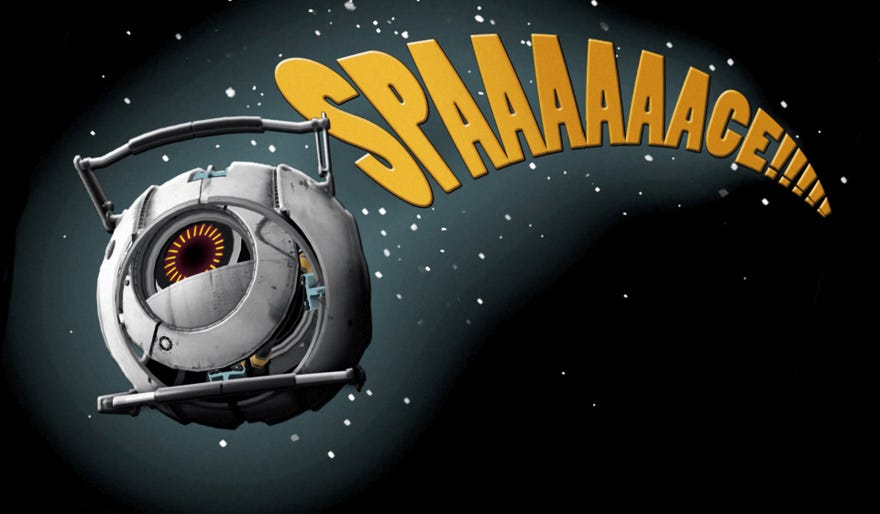Portal 2 was released a decade ago, so here are 10 facts about Valve’s classic puzzle game
Our boy Wheatley really did make it into orbit
Ten years ago, Valve released Portal 2. I’d like to think that the ultimate goal of Portal 2 was to get me to write an article about its tenth anniversary, so my ego wouldn’t let it go by. 10 is a nice age to celebrate, and it’s also the perfect number of random facts to pluck from the history of one of Valve’s most celebrated games. Also, I get to call them “decafacts”.
Portal 2 originally didn’t have any Portals in it
Valve’s initial experiments into a Portal follow-up jettisoned everything but Aperture Science. No Chell, no GLaDOS, no portals. No way!
The game was initially going to be set in the mid-’80s and based around a mechanic called “F-Stop”, which involved using a camera to grab sections of the game’s scenery to solve puzzles. You can see that here:
Though some elements of that version of Portal 2 still exist, with GLaDOS’ replacement Cave Johnson appearing heavily in the final game, writer Chet Faliszek pointed out at GDC 2012 that this wasn’t what people wanted in a sequel. He said: “It was a lot of things, but it wasn’t Portal 2.”
Valve swiftly added portals back into the game series called Portal, though they resisted adding Chell back as she wasn’t much of a character and had already escaped. Portal 2 was to star someone called “Mel”, but when the playtesters met GLaDOS again in the sequel and she didn’t know who Mel was, they felt like the game was missing the shared experience that the first game had built up. Chell was welcomed back to Aperture Science.
Portal 2 was announced inside Portal
There are two versions of the original Portal. The first one is the self-contained story that Valve released on 10 October 2007. That one’s dead, after Valve updated it to announce the sequel.
It was an elaborate scheme. They added 26 radios into the game that, when moved around, re-tuned to play a piece of morse code or a squelchy transmission sound. It was the sound files, found in Portal’s install folder and viewed through “slow-scan television software”, that contained scrambled Portal 2 imagery or even more morse code. The morse code led to a Portal-themed bulletin board that had to be accessed via a phone line and a 56k modem. They didn’t make it easy, but the payoff was the eventual announcement of the sequel. Valve went as far as to change the ending of the original game, adding a small sequence that suggested the escaped Chell was being dragged back into the facility for further testing.
The whole saga is detailed in this fan wiki, and it’s worth reading to remind yourself (or educate yourself) of how creative Valve were with it.
The game was released early via a second ARG

In a remarkable inversion of “Valve Time”, the localised phenomena that affects all of Valve’s development teams and causes many games to be delayed, Portal 2 was released hours before schedule.
In April of 2011, 13 seemingly unconnected indie games on Steam updated (including Audiosurf, Killing Floor, BIT.TRIP BEAT, and others) with “PotatoFoolsDay” in their patch notes. The update added a glyph into each game and a nonsense sentence, and all the games were bundled together and sold as “The Potato Sack”. As players picked apart the clues they were given logins and passwords to a website that let them download Portal 2 concept art.
There’s a lot more, that you can read about in this Gamasutra article. The ultimate goal was to play the 13 indie games to knock time off of Portal 2’s release date. It was a lot of work and only really resulted in a few hours being wiped off the launch time, but it did gather a huge number of participants and boosted the sales of a number of indie titles.
Portal 2’s new mechanics were based on a student game
Valve famously hired the team of DigiPen students who made Narbacular Drop, a game about navigating levels with portals, to make Portal. Though they didn’t do that for Portal 2, it’s still based on a student game from the same university.
Valve had hired the team who made Tag: The Power of Paint back before Left 4 Dead was released. The team worked on both L4D games before joining the Portal 2 team and introducing the gel mechanics to the game, letting the player coat specific parts of levels with gel that aids the character’s speed and jumping ability. A third gel, that allowed the player to walk on any surface it was applied to, was tested for Portal 2 but cut for the final release.
There is motion control DLC
Before VR, there was Razer’s Hydra. A small sphere with tethered controllers that could precisely track your hand movements. Valve supported the release of this forgotten nunchucky controller with a large level pack released for Portal 2.
It’s a shame this is tethered to a lost technology, because the additional puzzles were a lot of fun. You could stretch out the cubes that fill Aperture Science, creating bridges from the expanded boxes. It expanded the Gravity Gun capabilities of the Portal device, too, letting you move objects across larger spaces simply by reaching out. The tracking enabled players to precisely aim lasers around, and slide portals all over the walls. Here, have a peep.
There’s a number of official spin-offs
VR has been a good place to continue to play Portal 2, albeit without any portals. Valve used the game as a jumping-off point for a number of VR tech demos.
The Lab is set in an Aperture Science pocket universe. It’s a hub world for a number of VR tech demos, and includes the Portal stick figures working away in the background. Some of the demos in The Lab are 100% Portally. Slingshot has you fire 32 new personality cores around a warehouse to knock over boxes, while Robot Repair lets you inspect and ‘repair’ a broken Atlas from the co-op mode.
Moondust is a small playground filled with Aperture equipment set on the moon. It’s a demo for the first few iterations of Valve’s ‘Knuckles’ VR controllers, showing off the grip, joysticks, and finger-tracking of the new wands.
Aperture Hand Lab updates Moondust’s idea. In it, you play with a number of new personality cores as they show you around the Valve Index controllers’ new functions. This includes silly hand gestures and a game of Rock, Paper, Scissors.
There are three officially endorsed Portal 2 mods on Steam
Portal Stories: Mel follows the previously cut character of Mel as she puzzles her way through Aperture Science. It’s set between the two main games, and the puzzles are properly testing. It’s standalone and free, meaning you don’t even need to have the main game installed, but you do need to own it.
Thinking with Time Machine is a single-player co-op mode, and my favourite mod on this list. It enables you to record your movements in the game and then replay them to move you through the levels. The depth surprised me: you record yourself flicking switches, moving things, ducking and standing (to boost yourself) and firing portals.
Aperture Tag: The Paint Gun Testing Initiative fulfils the dream that Valve once dared to have: A Portal-free Portal game. As the name so cunningly suggests, this mod is based around the gels, making each level a parkour puzzle space that is far harder than the main game. You get to fire the gel out of the gun in this mod, bringing it far closer to the student game that inspired Portal 2. It’s also the only paid-for mod for Portal 2 on Steam.
There are dozens of games in the Portal 2 universe
Including all the games in the ARG and the VR, there are over 30 games that have an official Portal 2 connection. Bridge Constructor Portal is a physics puzzle game about building breakable bridges using Aperture Science’s creations. Rocket League has a number of Portal-based accessories for your cars. But my favourite is in Skyrim. In Fall Of The Space Core, Vol. 1, created by Valve for Bethesda’s RPG, the Space Core drops screaming into Tamriel, babbling about space.
Competitive Portal 2 multiplayer was briefly considered
If you’ve ever played the wonderful Portal 2 co-op mode, you know the havoc you can wreak by comedically portalling your partner around while they whine on voice chat, and then your housemate bangs on the wall and complains that your laughter is keeping him awake, and that your girlfriend is spending too much time in the flat, and…
That genuinely happened, btw. I suspect poor Phil would have had many more sleepless nights if Valve had made the competitive game mode. It involved two teams trying to manoeuvre a ball around a map. It was cut, as Erik Walpaw pointed out at GDC 2012: “We also tried a competitive multiplayer mode which we put together over the space of a month or two. It was a mix of the old Amiga game Speedball and Portal, except with none of the good parts of either of those two. The game was super chaotic and no fun, so the only good news about this part was that we cut it pretty quickly and were able to use those resources to develop co-op a little bit more."
I still want to play it.
Wheatly really did make it to space

In 2012, an anonymous NASA tech got in touch with Valve to show them a Wheatley decal they’d added to an ISS supply ship. As proud parents do, Valve let the world know, but with a disclaimer: “NASA in no way officially endorses secretly laser-engraving characters from Portal onto their spacecraft. Believe it or not, they don't even officially endorse Portal 2, despite the fact that it's a really excellent game.”

